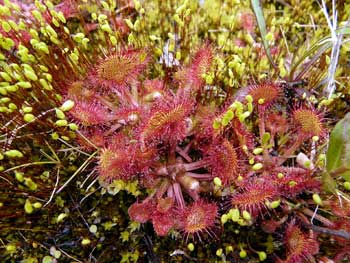Contents:
Common Names | Parts Usually Used | Plant(s) & Culture | Where Found | Medicinal Properties | Biochemical Information
Legends, Myths and Stories | Uses | Formulas or Dosages | Nutrient Content | Warning | Bibliography
Scientific Names

- Drosera rotundifolia L.
- Droseraceae
- Sundew family
Common Names
- Dew plant
- Flytrap
- Lustwort
- Round leaf
- Round-leaf sundew
- Youthwort
Parts Usually Used
The whole plant
Back to Top
Description of Plant(s) and Culture
Sundew is an insectivorous (insect eating) perennial plant; the root produces a basal rosette of nearly round, reddish, glandular-hairy, tiny, leaves 1/2 inch across, mostly wider than long, which exude a liquid (dewdrops) that traps insects. The leaves fold over the captured insect and digest it. Naked flower stalks, from 2-12 inches high, are topped by one-sided racemes of small, white or pinkish (sometimes red) flowers which bloom from June to August. Blossoms open one at a time.
Back to Top
Where Found
Grows in wet, acid, and moist places in North America, Europe, and Asia. In the United States, sundew is found in the eastern states, in the Rockies, and in the Sierra Nevada range. Also, Newfoundland to Florida; Illinois, Minnesota.
Back to Top
Medicinal Properties
Antispasmodic, expectorant, demulcent, stimulant
Back to Top
Biochemical Information
Proteolytic enzymes, naphthoquinone derivatives, plumbagin and hydroplumbagin, flavonoids, organic acids and traces of essential oil.
Back to Top
Legends, Myths and Stories
Sundew is a carnivorous plant with ninety species of the Drosera genus throughout the world. Digestive juices, analogous to pepsin, are excreted, and the insect is dissolved and absorbed.
Sundew is the smallest of the insect eating plants, it is about the size of a silver dollar. The Venus fly trap is of this family; its leaves are two-hinged blades, with sensitive hairs, that close when touched, thus entrapping the insect.
Back to Top
Uses
Effective remedy for respiratory ailments and chest problems, including coughs, asthma, whooping cough, catarrh, arteriosclerosis, and bronchitis. It is taken to help counteract nausea and upset stomach. The plant contains an antibiotic substance that, in pure form, is effective against Streptococcus, Staphylococcus, and Pneumococcus. In European folk medicine, the fresh juice is used for warts and corns, and is taken internally as an aphrodisiac. Also, used to help curdle milk.
Homeopathically: Epilepsy, hemorrhage, headache, laryngitis, nausea, measles, sciatica.
Folk medicine: used for diphtheria, plague, and nerve maladjustments and a “cure for old age”.
Back to Top
Formulas or Dosages
Only 1 tsp. of the dried herb steeped in a pint of boiling water. Throughout the day a total of up to 1 to 2 cups are taken in small mouthful doses. It is best sweetened with honey
Tincture: a dose is 3-6 drops.
Fresh juice: use a drop at a time on warts or corns.
Back to Top
Nutrient Content
Vitamin C
Back to Top
Warning
Sundew contains irritant substances and should be used in small quantities only. External applications may cause blisters on the skin. Use under medical supervision.
Back to Top
Bibliography
![]() Back to Eden
Back to Eden, by Jethro Kloss; Back to Eden Publishing Co., Loma Linda, CA 92354, Original copyright 1939, revised edition 1994
![]() Eastern/Central Medicinal Plants
Eastern/Central Medicinal Plants, by Steven Foster and James A. Duke., Houghton Mifflin Company, 215 Park Avenue South, New York, NY 10000
![]() The Herb Book
The Herb Book, by John Lust, Bantam Books, 666 Fifth Avenue, New York, NY. copyright 1974.
![]() Indian Herbalogy of North America
Indian Herbalogy of North America, by Alma R. Hutchens, Shambala Publications, Inc., Horticultural Hall, 300 Massachusetts Avenue, Boston, Massachusetts 02115, 1973
![]() The Nature Doctor: A Manual of Traditional and Complementary Medicine
The Nature Doctor: A Manual of Traditional and Complementary Medicine, by Dr. H.C.A. Vogel; Keats Publishing, Inc., 27 Pine Street (Box 876) New Canaan, CT. 06840-0876. Copyright Verlag A. Vogel, Teufen (AR) Switzerland 1952, 1991
 Old Ways Rediscovered
Old Ways Rediscovered, by Clarence Meyer, Meyerbooks, publisher, PO Box 427, Glenwood, Illinois 60425, published from 1954, print 1988
![]() Planetary Herbology
Planetary Herbology, by Michael Tierra, C.A., N.D., O.M.D., Lotus Press, PO Box 325, Twin Lakes. WI 53181., Copyright 1988, published 1992
![]() Webster’s New World Dictionary
Webster’s New World Dictionary, Third College Edition, Victoria Neufeldt, Editor in Chief, New World Dictionaries: A Division of Simon & Schuster, Inc., 15 Columbus Circle, New York, NY 10023
 The Rodale Herb Book: How to Use, Grow, and Buy Nature’s Miracle Plants (An Organic gardening and farming book)
The Rodale Herb Book: How to Use, Grow, and Buy Nature’s Miracle Plants (An Organic gardening and farming book), edited by William H. Hylton, Rodale Press, Inc. Emmaus, PA, 18049., 1974
